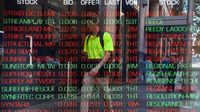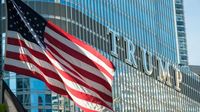The Australian sharemarket experienced a remarkable surge on April 10, 2025, following US President Donald Trump's unexpected decision to pause tariffs on all countries except China for 90 days. This announcement ignited a wave of optimism among investors, propelling the S&P/ASX 200 Index to its best one-day performance since the onset of the COVID-19 pandemic.
Early trading indicated a robust rally, with ASX 200 futures suggesting a 6.72% increase, translating to a potential gain of 497 points. When the market opened, the index spiked by 368.10 points, or 4.99%, reaching 7,743.1 points. Despite a decline of 1.48% over the past five trading sessions and a 1.34% drop in the past year, investors were eager to capitalize on the positive news.
ANZ Rates Strategist Jack Chambers commented on the rapid developments surrounding the tariff situation, noting that it unfolded at “breakneck pace” overnight. The ongoing tit-for-tat tariff war between the US and China escalated when China imposed an 84% tax on US goods, prompting Trump to increase tariffs on Chinese imports to 125% immediately. However, in a surprising move, he announced a 90-day pause on reciprocal tariffs greater than 10% against all other countries, effective immediately. Chambers explained, “So the 10% baseline tariff will stay, and larger tariffs are on hold, having been in effect for just over 12 hours.”
All 11 sectors of the S&P/ASX 200 rallied, with the materials sector leading the charge with a 6.48% increase in early trading. The financial sector also saw significant gains, jumping 5.56%, while utilities advanced by 4.19% and energy stocks gained 1.51%. The pause in US tariffs also contributed to a recovery in commodities, with the ANZ China Commodity Index edging up 0.3%.
Gold prices surged over 3.6% to reach US$3,086 ($5,038) an ounce, with silver rising 4.2% to around US$31 an ounce and copper spiking 8.2% to US$9,677 a tonne. Notably, copper producer Sandfire Resources (ASX:SFR) saw its shares rally by 14.85% to $9.36, while diversified miner IGO (ASX:IGO) jumped 14.1% to $3.56. Mineral Resources (ASX:MIN) also recovered some losses, adding 13.54% to trade at $16.35 early in the session.
Despite the positive momentum, Chambers cautioned that metal markets might remain jittery due to the increasing focus on China by Trump. The S&P/ASX 200 serves as Australia’s leading share market index, encompassing the top 200 ASX-listed companies based on market capitalization, and accounts for about 80% of the country's equity market.
As the Australian market opened, it mirrored the sharp rally seen on Wall Street, where the S&P 500 soared 9.5%, marking its largest one-day gain since 2008. This surge added approximately $4.3 trillion (around $7 trillion) in market value. The Australian dollar also rebounded, nearing US62¢, buoyed by the burst in risk-on sentiment.
However, the optimism was tempered by the reality of ongoing trade tensions. Trump’s announcement to raise tariffs on Chinese goods to 125% was a clear indication of the escalating trade war. In a social media post, Trump stated, “Based on the lack of respect that China has shown to the World’s Markets, I am hereby raising the Tariff charged to China by the United States of America to 125%, effective immediately.”
China retaliated by increasing its tariff on US exports to 84% from 34%. This back-and-forth has left many analysts concerned about the long-term implications for global markets. Jessica Amir, a market strategist at investment platform MooMoo, remarked, “Markets have been oversold, and that will encourage people in. But what we know from Trump is that markets are triggered by headlines.”
In the wake of these developments, the Reserve Bank of Australia (RBA) is closely monitoring the situation. RBA Governor Michele Bullock, speaking at the Chief Executive Women Melbourne Annual Dinner, emphasized that while the current circumstances are challenging, they do not yet resemble the global financial crisis of 2008. She stated, “Inevitably, there will be a period of uncertainty and adjustment as countries respond to the ongoing tariff announcements by the United States administration.” Bullock reassured that the Australian financial system is strong and well-placed to absorb shocks from abroad.
As the situation continues to evolve, analysts predict that the RBA may consider slashing interest rates in response to the economic fallout from the trade tensions. The National Australia Bank forecasts a 50 basis point cut next month, with additional cuts anticipated in July, August, November, and February. “Headwinds from the global environment have intensified, but error bounds around our forecast are large given uncertainty remains exceptionally elevated,” noted NAB chief economist Sally Auld.
Overall, the Australian sharemarket's reaction to Trump's tariff pause highlights the delicate balance of investor sentiment amidst ongoing global trade tensions. As markets fluctuate, the focus remains on how these developments will shape economic prospects in the coming months.









